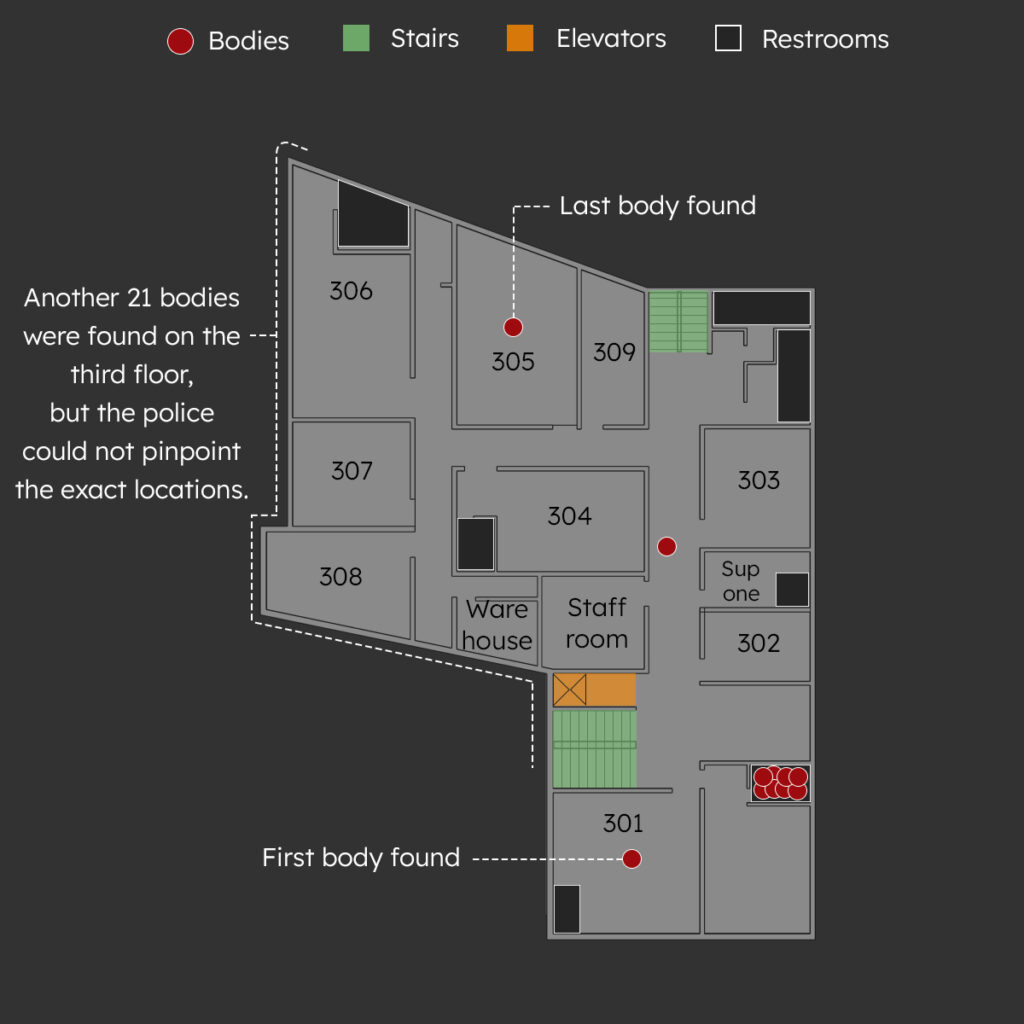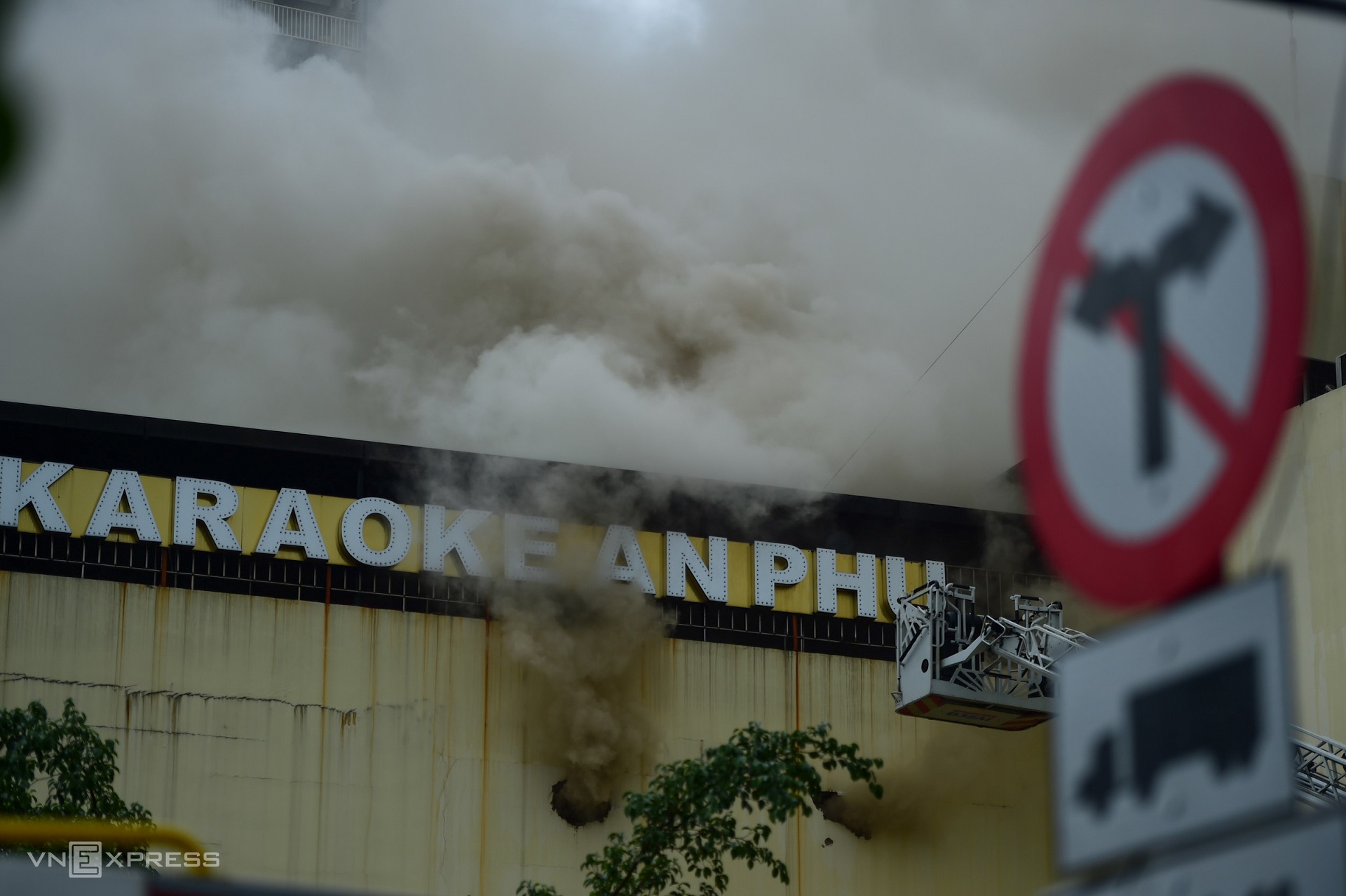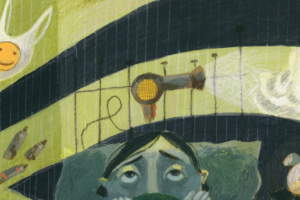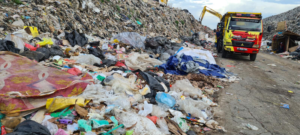To mark World News Day on September 28, 2022, the World News Day campaign is sharing stories that have had a significant social impact. This particular story, which was shared by VnExpress (Vietnam), was published on September 14, 2022.
“Either jump or die,” Phuc told himself on turning around to see a blaze sweeping through the glass window of the restroom he was standing inside.
From the ventilator window of the restroom, he tried to locate the metal roof of the house next door and jumped down.
That decision saved his life.
Phuc is one of the 30 survivors of a deadly fire that took place last week at the An Phu karaoke parlor in the southern province of Binh Duong.
Thirty-two others perished.
Caught in the deadliest fire to occur in Vietnam in the past 20 years, survivors have lived to the tale of confronting imminent death – an unforgettable experience.
Nguyen Trong Phuc started his night shift at the karaoke parlor at 6 p.m. on Sep. 6.
The 18-year-old was new to the place, having worked at the parlor in Thuan An Town, around 50 km from Ho Chi Minh City, for less than a month.
“My parents divorced when I was a kid. I grew up with my maternal grandmother and still live with her. I had an accident several months ago and broke my arm. She had to take care of me. Now I must work and earn money to make it up for her.”
An Phu was one of the most popular venues for partying in Thuan An. It covered a floor area of more than 1,500 square meters on three stories. The rooftop of 500 square meters had been modified to provide accommodation for female employees.
The walls in each of the parlor’s 30 karaoke rooms were designed with three layers: soundproof foam mattress, plywood and decorative plastic panels.
Male employees like Phuc were in charge of allocating guests first into the 10 rooms on the third floor, then the 13 rooms on the second, and finally, seven rooms on the ground floor.
On the evening of Sep. 6, Phuc received the first group of customers soon after he started his shift. The next customers arrived in groups of four to seven each. Together, they filled up half the rooms on the third floor.
“Most of them were already quite drunk when they got there,” Phuc recalled.
Apart from allocating customers, male employees at An Phuc are tasked with receiving orders for drinks and food and cleaning up the karaoke rooms later.
“Only female employees stay in the rooms to serve the customers. Their number is equivalent to the number of customers,” Phuc said.
That night, everything was “normal,” with all customers singing and dancing passionately and some rooms ordering a second box of beer. There was no customer on the second and ground floors.
The normalcy was broken rudely with the sound of someone screaming, Phuc said.
“Smoke! There’s fire in the room,” two customers screamed as they rushed out of room No. 303 and ran downstairs.
At that moment, Phuc thought it was probably an electrical short, so he went in with the intention of switching the room for those customers. But the smoke spread out quickly and started to seep out from the gap on the door of that room.
Phuc and another male employee got in to inspect the situation, but “we were hit in the face by the smoke even though the fire could not been seen.” By then, black smoke was also rising along the two stairs leading to the third floor.
He yelled into his walkie-talkie: “Anyone there? There’s fire up here!”
There was no response, just screams and chaotic sounds.
At that moment, on the ground floor, Ngoc, the cashier, saw a tall, thin, topless man rushing down the stairs with his shirt hung on his shoulder.
“Fire. Fire. Too much smoke!” he screamed.
Panicking, Ngoc grabbed the fire extinguisher at the foot of her table, pressed it into the hand of another employee.
She continued to run to the corner of the hall to get more fire extinguishers and take them upstairs, but she could only reach the stairs. Smoke was all over the place. She had to turn back.
She then saw some people running down from the third floor and fled the bar immediately.
She also saw guards trying to get to the second and third floors but to no avail. She heard the manager urging people to call 114 — the firefighters’ hotline.
At that time, the second floor was engulfed in flames, completely cutting off the third floor from the rest of the building.
Phuc and another male employee knocked on the doors of rooms on the third floor and tried to scream as loud as possible to inform them of the fire but they kept singing.
The power was cut shortly after, leaving the entire parlor dark and filled with smoke.
“Usually, when the power goes off, female employees serving customers would reassure them, saying ‘the power will come back after a while’,” Phuc said, guessing that might be the reason the customers did not get out.
Phuc tried to reach the stairs and go down, but the smoke suffocated him.
He went into a room on the third floor that had no customers inside, got into the restroom, and shut the door to escape the smoke. He washed his face to compose himself and then rushed out, only to see that the flames had grown even stronger and was about to spread to the restroom.
He made a quick decision: take a risk and jump down.
Standing on the toilet, he climbed through the ventilator window and jumped down from a height of around 10 m. He fell onto the metal roof of the house next to the parlor and broke his right leg.
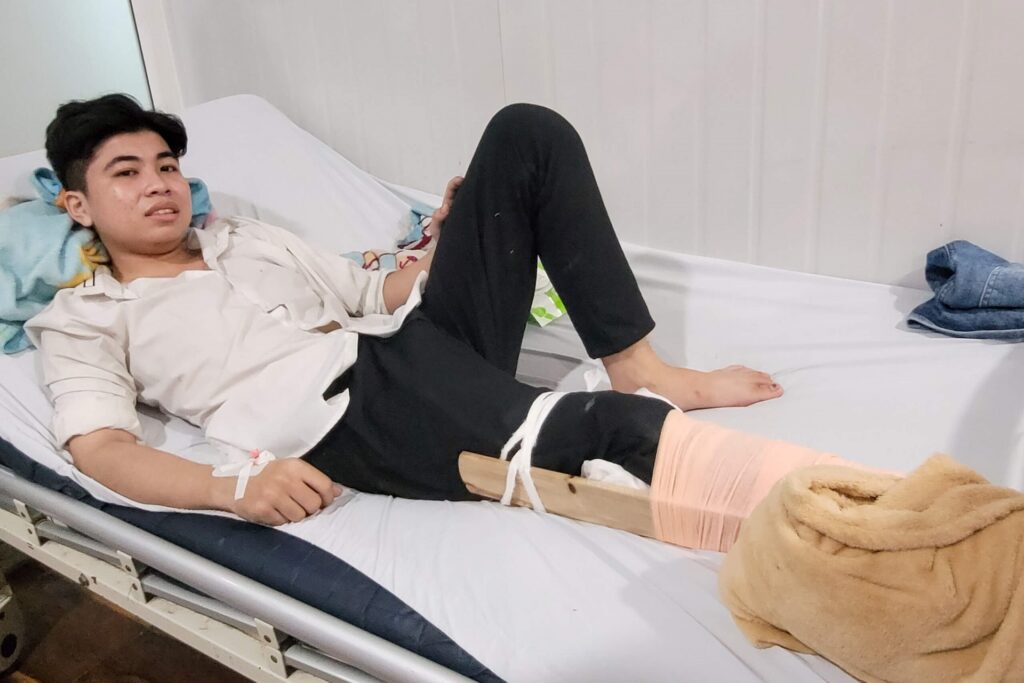
As Phuc tried his best to save himself, on the rooftop, female employee Truong Kim Nhi, 27, and two of her colleagues “heard people downstairs screaming about the fire.”
The three women planned to run downstairs, but the fire, heat, and smoke coming up from below did not allow them to do so.
They rushed to the balcony of the rooftop. Telling each other that they have to jump down now or get burned to death, they climbed through the balcony.
Looking down, Nhi, a single mom, was so scared that she wanted to get back yet she quickly changed her mind as by then, she could already feel the heat of the floor beneath her feet.
The three women jumped down on to the same metal roof as Phuc.
The leap left Nhi stunned. She tried to use the remaining strength she had with the support of local people to climb down from the roof. Two ankle bones were broken, but she was alive.
As she heard a fire siren howling in the distance, Nhi looked up at the waves of fire blazing from the third-floor window and wondered how many of her friends had managed to escape.
‘All a bit scared’
At 8:40 p.m., fire-fighter trucks of the Thuan An police department were dispatched to the scene. All the firefighters in the province were also mobilized and they brought with them several vehicles to rescue people and put the flames out.
In his decade-long career as a firefighter, Senior Lieutenant Le Quang Tuan, 34, had never dealt with a fire at a karaoke parlor before.
“As soon as I heard the news, I thought about the fire at a Hanoi karaoke parlor that claimed the lives of three firefighters [on August 1]. This one had the same number of floors. We were all a bit scared,” Tuan said, adding that most fire incidents in Binh Duong have to do with factories and companies, with wide floor areas but casualties were rare.
At the site, the flames were raging and licking all over the building, like a lighthouse in a sea of darkness. Black columns of smog and fumes spread around the premises, threatening anyone who dared to get too close.
“The front of the store has been covered with LED lights and wallpapers. There were no balconies on the sides of the building. The parlor itself was narrow and led deep inside, with multiple enclosed rooms. The moment I arrived, I knew this was going to be trouble,” Tuan said.
Lieutenant Colonel Bui Trong Hieu, deputy head of the Binh Duong firefighting police department, split the forces into specialized teams and approached the site. The foremost priority was rescuing the ones trapped on the roof.
“It was as if they were in a cage made of fumes,” Hieu recalled. He saw hands reaching out of the metal bars and heads bobbing up and down as swirls of black smokes enveloped them. The women inside were screaming and catching their breaths at the same time. Many of them were still in their pajamas.
Hieu and Tuan got into a truck and tried to use ladder to get to the victims. As they got closer, they began to make out the faces amidst the smokes – faces painted with black soot and desperation.
“Please save us! I can’t breathe anymore!” one screamed.
“Everyone remain calm! Whoever’s at the front will get out first, and no pushing! Everyone will be rescued!” Tuan shouted out. He proceeded to tear down several bars, making enough room for one person to slide in.
Hieu turned himself into a human scaffold for those inside to get out. 12 people were rescued, many of them suffering from severe burns and asphyxiation. They were taken to the An Phu Hospital just 500 m away.
When the screams began to die out and the flames at the parlor’s signpost were put out, Hieu hoped everyone inside had managed to get out.
It was 9 p.m.
“I wish everything had ended there.”
‘Parlor of death’
“There are still 5-6 people trapped on the second floor!” a male employee shouted at the firefighters. Hieu realized that they could not accurately determine how many people were still left inside.
A rooftop check revealed that it could not be used to gain access to lower floors due to the flames and heat. The teams had to change course and try to get inside from the ground and the sides of the building.
As the first team to head in, staff sergeant Nguyen Huu Tinh, 26, led his group towards the third floor. The last one on the line was in charge of putting out surrounding flames with a fire hose, and also wetting the clothes of the team to reduce the heat.
The moment they stepped onto the second floor, Tinh could see embers flashing on the walls of the hallway. The fumes got into their noses and their eyes. Everyone had to crawl on the floor as closely as possible, unable to see ahead of them. It only got worse once they reached the third floor; the water almost instantly vaporized once they made contact with the walls.
“It was like a boiler room,” Tinh said.
Through his protective glasses, Tinh strained his eyes to look for any light coming from three flashlights the team brought with them. The only sounds he heard were of their own footsteps and water bouncing off objects in the hallway. The heat was unbearable, yet Tinh felt chills running down his spine.
Tinh pushed away a door leading into the first karaoke room he found. Stumbling in the darkness, he tried to make sense of the void around him so he could lead the entire team behind him. His hand laid on something soft.
It was a man in short jeans with a naked torso. He was in fetal position. He was dead.
“Despite wearing gloves, I could still feel the immense heat coming from his body,” Tinh said. He gathered his strength and lifted the body up with his team, trying to find their way back to the ground floor. It was the first victim they found in room 301.
By this time, over 100 firefighters had been dispatched to the fire site. The residual heat on the third floor was still too great however, making rescue efforts very difficult. Scouts could only go in for around 15 minutes before having to run out to replace oxygen tanks.
Hieu said the karaoke parlor was designed as an enclosed space, so there was no way for the smoke and heat to escape. Efforts to breach the walls and the roof to put out the fire inside also proved very difficult, as there were soundproof sponges and other objects in the way.
Twelve hours after the fire had broken out, smoke was still coming off the roof and holes in the walls. Firefighters spent the entire night trying to put out the flames. Ambulances went in and out constantly and the number of casualties kept going up by the hour.
As of September 7 afternoon, all karaoke rooms had basically been scouted. The scouting team led by Tuan was tasked with breaking doors down.
“I hoped we wouldn’t find anybody.”
There was something blocking the door to the restroom. Three firefighters had to push at the same time to even budge it. A slight crack opened, and an indescribable smell came pouring out. Soot and burned fat.
“That smell haunts me even now,” Tuan said.
The team soon realized what was blocking the door: eight bodies stacked on top of one another.
“It was too painful. That image will follow me for the rest of my life,” Tuan said, adding that the restroom was where most of the bodies were found.
The search for victims lasted 23 hours and a total of 32 bodies were found. It was the most tragic fire in Vietnam in the last 20 years after a fire at the ITC building in Ho Chi Minh City claimed the lives of 60 people in October 2002.
In all his 22 years as a firefighter, Hieu had never seen such a devastating incident.
“Just 400 square meters caught fire, yet 32 lives were lost… It was truly a parlor of death.”
